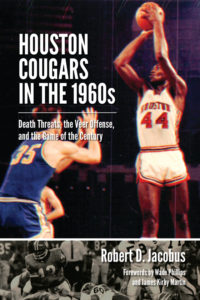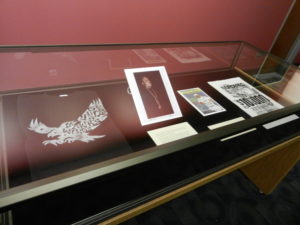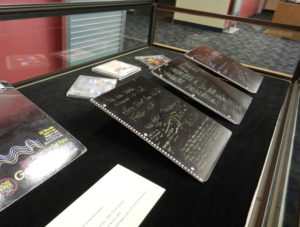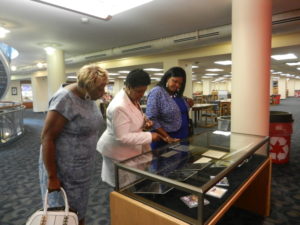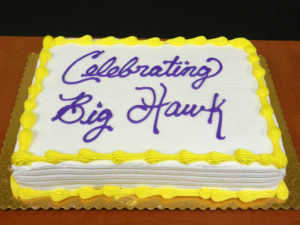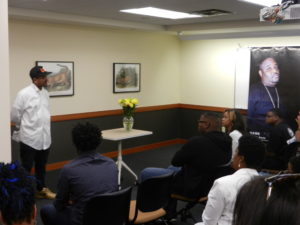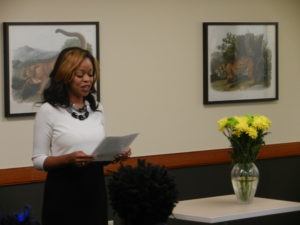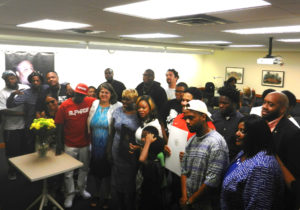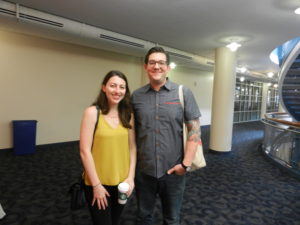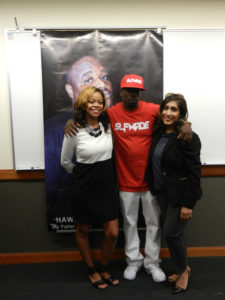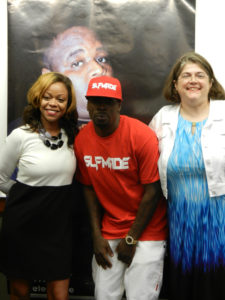
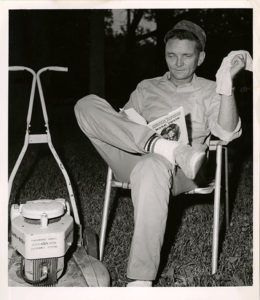
Photograph of Leon Hale via the Leon Hale Papers, University of Houston Special Collections.
In a journalistic career that has spanned over 65 years, with a daily column at the Houston Post that ran from 1948-1984 and the Houston Chronicle from 1984-2014, Leon Hale has literally written about the who, what, when, where, and why that so many journalists attempt to capture. His folksy, plain, straightforward style of writing, as he eschewed fancy complex words, elevated the ordinary musings and experiences into the extraordinary which would have his readers laugh out loud or cry, sometimes both, and in the process take his readers along on his adventures to small towns and locales all across Texas and beyond.
Nothing was too mundane or ordinary to write about, whether it was his personal experience of trusting and biting into a jalapeño pepper at a roadside store near Somerville and then describing its agonizing effects in detail, to the little things we all notice when the power goes out–the quiet, the darkness, neighbors congregating outside, and especially no A/C in the summer.
It’s these little slices of humanity and the interesting cast of characters that he has come across along life’s journey as a reporter that has endeared him to many of his faithful readers along the way for so many years. He’s touched many lives as the history of families and the places he has visited are captured in his daily columns with the Houston Post.
The Leon Hale Papers are part of the Houston & Texas History Research Collection at the University of Houston Special Collections.
We at UH Special Collections pay tribute to Michael Galbreth (1956 – 2019), whom we have had the enormous pleasure of working with and getting to know. Galbreth and the other half of the Art Guys, Jack Massing, donated their archives to Special Collections in 2013. And just over a year ago, Galbreth donated the New Music America Collection. Galbreth organized the 1986 NMA festival in Houston and served as president of its governing board, the New Music Alliance, from 1986 to 1989. A finding aid is available for this collection.
Through photographs of materials that Galbreth has donated to UH Special Collections–particularly from the recently acquired New Music America Collection–we aim to highlight the stories that they tell. A number of institutions and individuals have also commemorated the importance of Galbreth’s life to Houston and the art community, including:
- Remembering The Art Guys’ Michael Galbreth (University of Houston)
- Pay Attention: What I Learned from Michael Galbreth (Glasstire)
- Art Guys legend Michael Galbreth dies (Houston Chronicle)
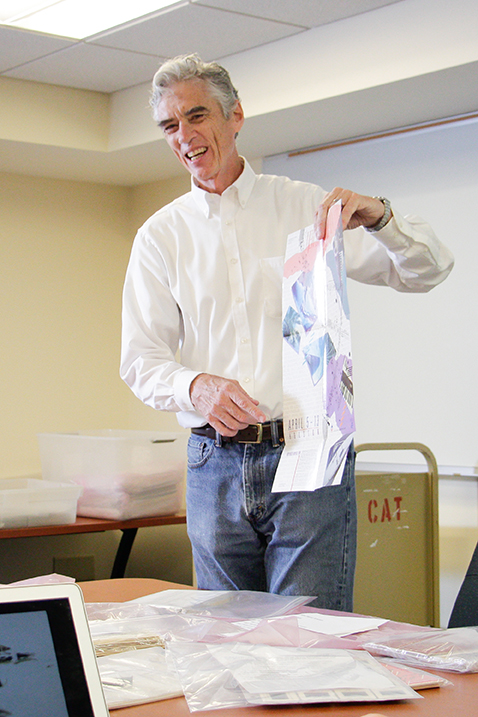
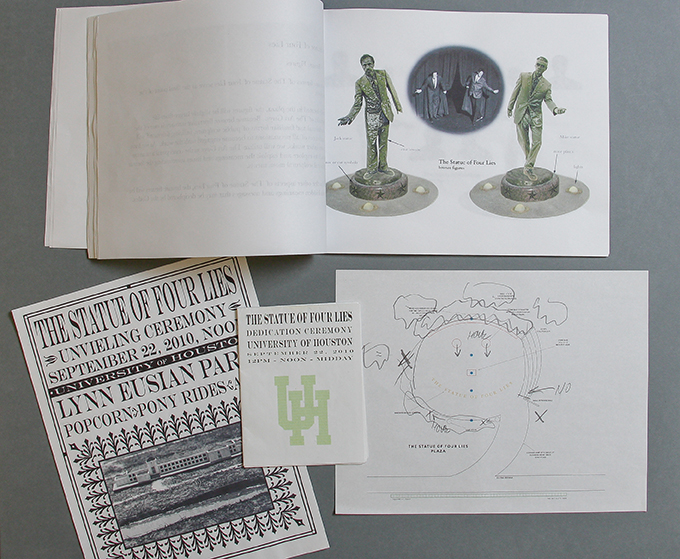
Among the approximately 84 boxes (and over a terabyte of electronic files) that make up The Art Guys Records are materials documenting the creation of The Statue of Four Lies, part of the UH Public Art collection. This selection of items shows an early mockup of the plaza where the statue is installed in Lynn Eusan Park. Other items include the proposal for the statue and a flyer and invitation to its unveiling.
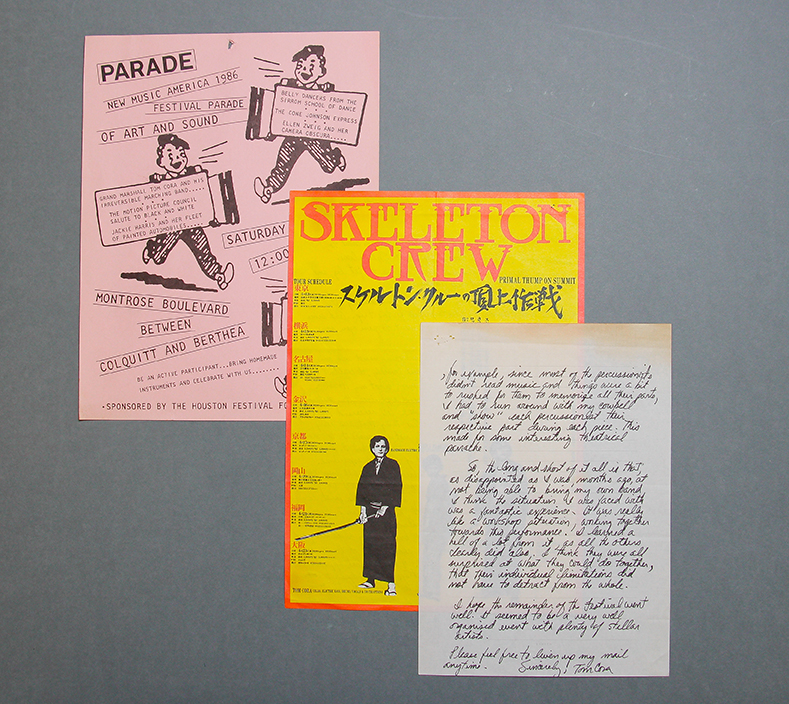
These items from the New Music America Collection document a parade with the Irreversible Marching Band led by musician Tom Cora during the 1986 NMA Festival held in Houston in 1986. Included are a flyer advertising the parade, which happened on April 5, 1986, and a two-page letter to Galbreth (one page on the back of a tour schedule for Cora’s band Skeleton Crew). In the letter, Cora writes: “Did you see the parade? The marching band was somewhat of a rag-tag unit, to be sure; but I couldn’t have been more pleased with the experience. What my Houston musicians lacked in musical skills and experience, they certainly made up for in enthusiasm and hard work.”
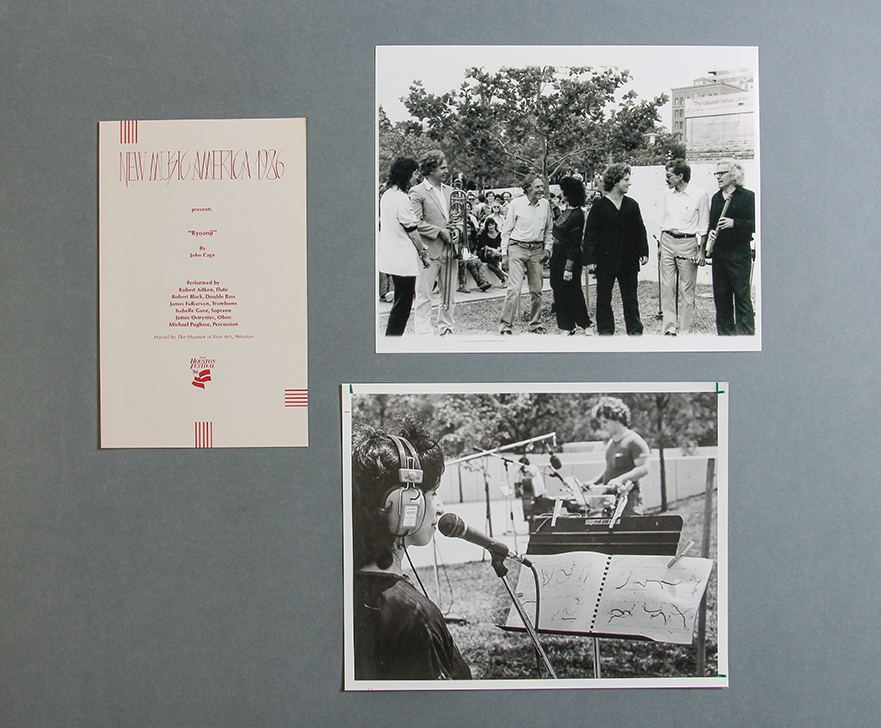
The 1986 New Music America parade culminated at the grand opening of the Cullen Sculpture Garden at the Museum of Fine Arts Houston, where John Cage performed. Included in this image are a program of the NMA event for Cage’s “Ryoanji” and two photographs, one of Cage and the musicians who performed with him that day and another of soprano Isabelle Ganz in front of Cage’s score.
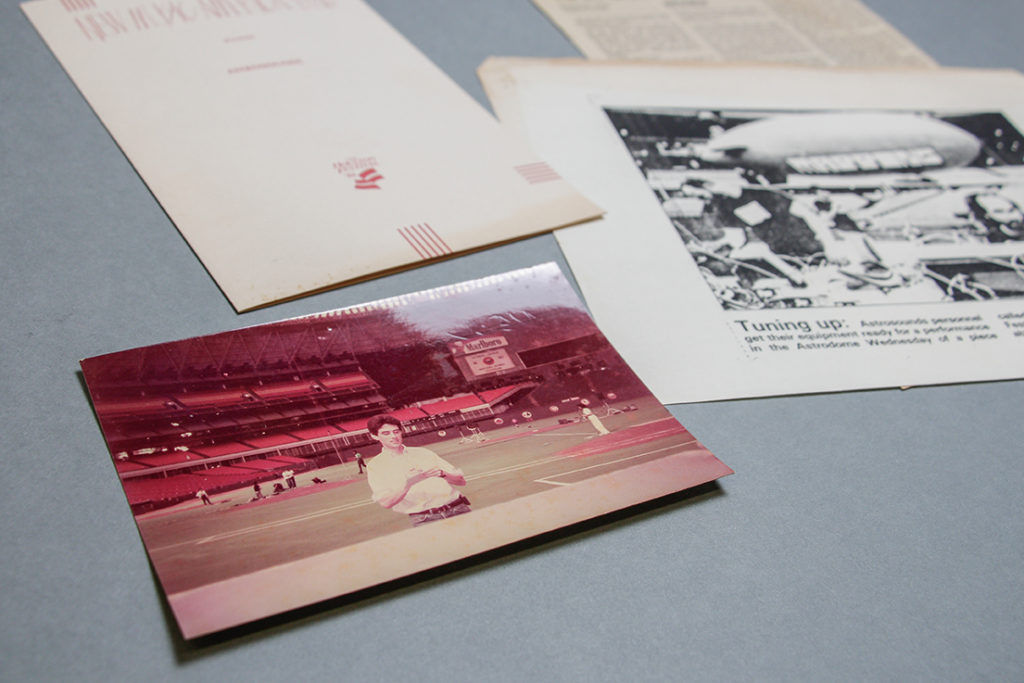
Among the Houston NMA events was Astrosounds, an experimental music concert inside the Astrodome that included a performance in which Russell Frehling launched a blimp equipped with a microphone, monitoring radio waves and feedback patterns in the space. Pictured here are a program, news clippings, and a photograph of Galbreth in the Astrodome on the day of the performance.
College basketball used to be a small game. A niche sport, once it was played on small courts, in small gymnasiums, in front of small crowds. Just over fifty years ago however, on January 20, 1968 in the Astrodome, the University of Houston (and the University of California, Los Angeles) forever altered the scale of the game in what has become known as the Game of the Century.
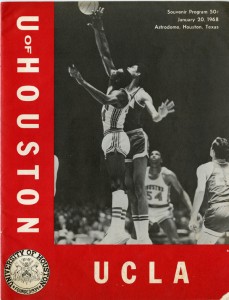
program from the Game of the Century (Athletics Department Records)
Regardless of the particulars, it was destined to be a historic match-up. While any given season might feature similar, high-profile, games between highly ranked teams, the 1968 regular season game between UCLA and Houston had a number of compelling story lines that intrigued even the casual sports fan. There was the blue blood, #1 team in the nation (the UCLA Bruins), riding a 47 game winning streak that spanned two and a half years and boasting three of the last four national championships under the tutelage of the legendary “Wizard of Westwood,” John Wooden. Their most recent in 1967 included a 73-58 defeat of the University of Houston Cougars in the Final Four. Anchored by the immeasurable talent of Lew Alcindor (later known as Kareem Abdul-Jabbar), the UCLA Bruins were a legitimate dynasty, ultimately claiming every national championship between 1967 and 1973. In the other corner, the up-and-coming “underdog” program, ranked #2 in the nation and riding their own winning streak (undefeated since their loss to UCLA the previous season), the University of Houston Cougars were coached by Guy V. Lewis, led on the court by the likes of Elvin Hayes, Ken Spain, and Don Chaney, and eager to prove just how good they were after last year’s setback.
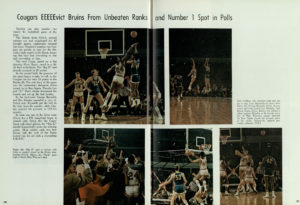
a full-color, two page spread from the 1968 Houstonian yearbook documents the Cougars’ victory
Given all of these particulars, how could the game be any bigger? Mix in a grand stage of national television coverage (a first for college basketball) and the surreal setting of the Eighth Wonder of the World.
The court for the contest was shipped in from Los Angeles, ironically enough, and assembled in the Astrodome on top of what should have been second base. It must have looked like a postage stamp to most of the 52,693 fans (a world-wide attendance record for any basketball game) packed into the dark corners of the Dome. Even more watched at home as this “small” game was played against a grand, cavernous backdrop.
TVS Television Network promoted the game and sold broadcasting rights to over 100 television stations across the country. Previously, there had only been efforts to televise games locally and in 1961 a “national” broadcast of the Ohio State / University of Cincinnati game in the NCAA finals was televised in just two cities–Columbus and Cincinnati, Ohio. The pros in the National Basketball Association had only begun the broadcast experiment in the 1950s and were still torn on whether or not they wanted to televise the league’s “good games,” for fear of losing ticket revenue at the turnstile. What was happening now in 1968 was not just novel, it was radical. And, it was successful in more ways than one. Houston defeated UCLA 71-69, ended the Bruins winning streak, and solidified their place in college basketball lore.
In Houston Cougars in the 1960s: Death Threats, the Veer Offense, and the Game of the Century by Robert Jacobus, Houston’s Elvin Hayes reflected back on the legacy of the game saying, “It just created euphoria and an atmosphere for college basketball that wasn’t there previously. I think that game kicked the door down, opened the windows, and knocked the roof off the house. What we have today in March Madness is what I think the game in 1968 opened.”
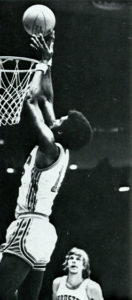
Dwight Jones tips it in against the University of Southwestern Louisiana (Houstonian, 1973)
Last week we lost a Houston basketball icon in Dwight Elmo Jones, who passed away on July 25, 2016 after battling a heart ailment over a number of years.
Before Clyde Drexler dunked his way to H-Town fame at Sterling High School, helped establish Texas’ Tallest Fraternity, and claimed an NBA title with his hometown Houston Rockets, Dwight Jones had already established himself as arguably the greatest high school basketball player in Houston history. Born in 1952 in Houston, Jones led Wheatley High School to three straight state championships from 1968 to 1970, played for the Cougars from 1971 to 1973, and even contributed to the Houston Rockets, from 1976 to 1979.
Coaches and teammates of Jones remember him being a special talent from a young age. Playing as a man among boys, playground lore suggests he was already dunking a basketball in the seventh grade. In high school, his Wheatley Wildcats racked up a remarkable 102-2 record and as a senior he averaged 28 points and 24 rebounds a game for the Wildcats in the newly desegregated University Interscholastic League. Recruited by the legendary Guy V. Lewis, Jones played on two NCAA Tournament teams for the Cougars while also leading the 1972 USA Olympic team in scoring before being ejected in the infamous gold medal game, as the Americans fell to the Soviets. Jones was drafted by the Atlanta Hawks in 1973 before joining the Rockets in 1976. His career in the NBA would run through the early 1980s and include stops with the Chicago Bulls and the Los Angeles Lakers.
A fierce competitor, his resolve was no doubt tested when he heard himself declared dead prematurely in an emergency room in 2012. Yet, to everyone’s surprise (except perhaps those closest to him), he survived the surgery and battled his illness with a fervent spirit for nearly four more years. In remembering Jones, current University of Houston Head Coach Kelvin Sampson said, “Dwight was a tremendous competitor, who represented the University of Houston and his nation well during his playing career. While his health declined in recent years, he faced those challenges with the same courage and spirit that made him one of our program’s greats. Tonight, our hearts go out to Dwight’s family and friends and all those who knew and loved him.” The Jones family has established a gofundme page to help defray the expenses they now face.
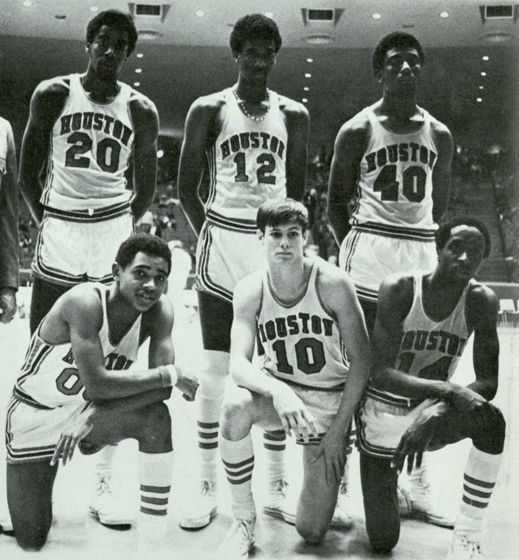
Dwight Jones (#12) and his freshman teammates pause for an impromptu team photo of the Cougar Kittens (Houstonian, 1971)
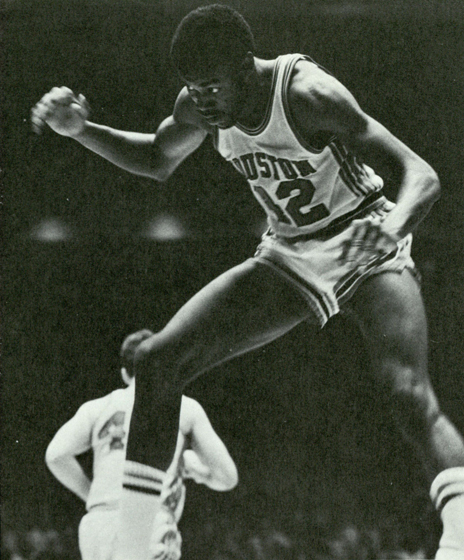
Jones showed his potential early as a freshman, scrimmaging against the Cougars’ varsity team (Houstonian, 1971)
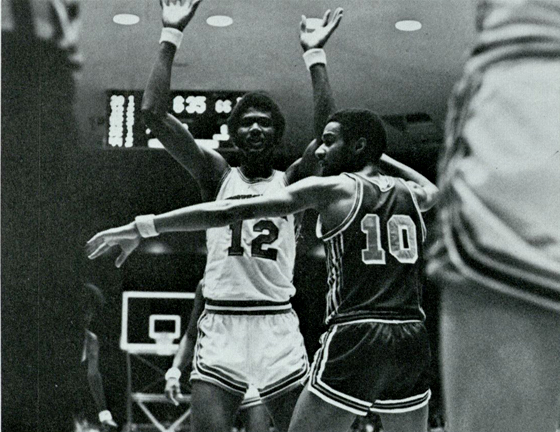
Jones awaits the inbound pass (Houstonian, 1973)
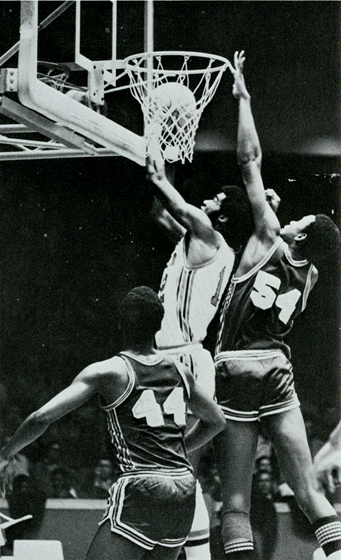
Jones scores two against tough defense (Houstonian, 1973)
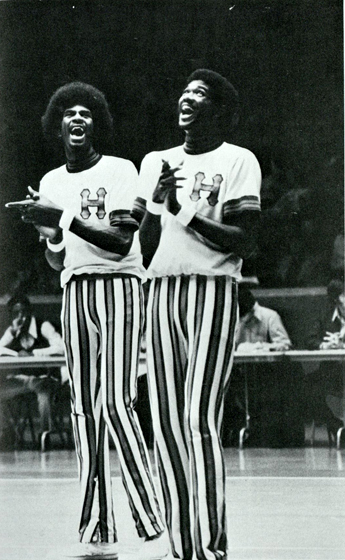
“Sweet Lou” Dunbar and Dwight Jones share a lighter moment during the pregame (Houstonian, 1973)
Ten years after the murder of John “HAWK” Hawkins, Mayor Sylvester Turner proclaimed May 8 “Big Hawk Day” in commemoration of the Houston rapper’s life and career.
View pictures of the event below and learn more about “Big Hawk” via the HAWK Papers or the HAWK Photographs and Memorabilia digital collection.
- Louella Hawkins, Paula Roberts, and Catina Hawkins
- Julie Grob
- Jay Ellis
- Meshah Hawkins
- Todd Spoth
- Meshah Hawkins, Lil’ Keke, and Sarah Syed
- Meshah Hawkins, Lil’ Keke, and Julie Grob
